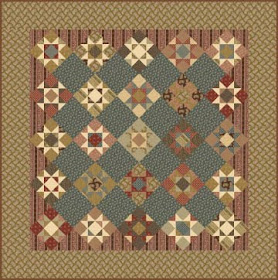 Civil War Home Front, designed by Barbara Brackman & Susan Stiff, pieced by Monica Rodarmer, 2009, 79 1/2" x 79 1/2".
Civil War Home Front, designed by Barbara Brackman & Susan Stiff, pieced by Monica Rodarmer, 2009, 79 1/2" x 79 1/2".I hope you noticed the full-page advertisement for my Civil War Home Front reproduction collection for Moda in the October Quilters Newsletter. It features a reproduction quilt that makes the most of the stripes and paisleys in the collection.
We are selling kits for this quilt, which is the result of a collaboration by five people. One is the anonymous maker of the original star quilt, in the collection of the International Quilt Study Center and Museum (#1997.007.0644). See it by clicking here:
http://www.quiltstudy.org/includes/photos/quilt_database/large/1997_007_0644.jpg
The pattern for the quilt will be in the Dec/Jan 2009 issue of Quilter's Newsletter magazine. And the bolts should be in the quilt shops in late November.
 Hickory Hoops stripe above and Cracker Pie paisley. Below a woman with the ideal silhouette for Civil-War-era fashion.
Hickory Hoops stripe above and Cracker Pie paisley. Below a woman with the ideal silhouette for Civil-War-era fashion. I named the individual prints in this collection for the make-do substitutes that Southern women came up with when they lost their access to factory and imported goods. The stripe in the edge triangles is called Hickory Hoops, reminding us that many rural women used wooden slats for home-made fashion underpinnings to support skirts like the one above. The paisley in the border is Cracker Pie, a recipe for a fake apple pie using seasoned crackers as the filling. Click on the link for a World War II era recipe for cracker pie, an idea that may have originated before the Civil War.
I named the individual prints in this collection for the make-do substitutes that Southern women came up with when they lost their access to factory and imported goods. The stripe in the edge triangles is called Hickory Hoops, reminding us that many rural women used wooden slats for home-made fashion underpinnings to support skirts like the one above. The paisley in the border is Cracker Pie, a recipe for a fake apple pie using seasoned crackers as the filling. Click on the link for a World War II era recipe for cracker pie, an idea that may have originated before the Civil War.Cracker Pie
http://www.cakespy.com/2008/09/american-pie-recipe-for-quick-fix.html































